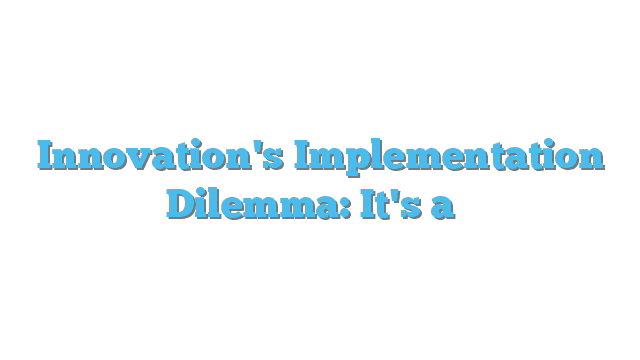Innovation Implementation: The Double-Edged Drain On Enterprises and Startups Alike — by Toby Olshanetsky, CEO/Founder of prooV
Enterprises need innovation. The drive for companies of all sizes toward ‘digital transformation’ requires an entirely new way to think about customer engagement, best business practices, and the backend technology necessary to effectively drive organizations into the digital future.
Fortunately, there are plenty of B2B startups and Independent Software Vendors (ISVs) that can deliver on the innovative front. Startups coming of age during this digital disruption aren’t hampered by legacy systems and the need to transition. They’ve created solutions designed from the ground up to meet the needs of enterprises now, and to grow with them into the future. Whether IOT, big data, mobile, cyber security, machine learning or analytics, software vendors all over the world are delivering cutting-edge, sophisticated, and highly relevant solutions for the needs of the modern enterprise.
On the surface, this win-win situation seems straightforward enough: enterprises need innovation, and there are a host of B2B startups ready and able to provide it. However, when you dig a little deeper you find out just how complex the problem is for both sides of the equation.
Knowing Where To Look
One of the most significant issues for both enterprises and startups is access. With hundreds, and sometimes thousands, of B2B startups all over the world that offer a service the enterprise is looking for, it’s a needle-in-a-haystack proposition to find them. Conversely, B2B startups face a daunting task trying to find the right prospect in the right company, at the right time, who is ready and able to consider their technology.
The Cost Conundrum
Along with access, comes the pressures of added cost in the form of both time and money. Most implementation champions within an organization — whether they come from the C-suite or the project management team — have little to no time to put into an implementation project. They know what they need for their business, yet the task to find the best solution that can deliver to scale is typically an added job requisite to an already full workload. In addition, the requirements of setting up testing environments, providing data, evaluating security, and waiting out the testing cycle can cost an organization hundreds of thousands of dollars before a decision has ever been made.
For B2B startups specialized in software, the costs associated with the PoC (Proof-of-Concept) process can be even more painful. The time demands on travel, securing meetings, pitching and providing demos can needlessly task limited budgets and resources. What’s more, if they are chosen to participate in a PoC or pilot, it often requires thousands more to be ready.
A Fair Evaluation
For startups, there is often little insight into the root of the problem that spurred the enterprise into looking for a new solution. In fairness, that insight isn’t always available at the enterprise level either. For enterprises it is often a matter of filling a need, and sometimes the base root for that need isn’t clearly communicated. In order to be properly evaluated on the capabilities of its solution, B2B startups must ensure they have a solid understanding of the pain points their solution needs to solve for the enterprise.
On the flip side, the enterprise needs to evaluate software vendors in as real-world scenario as possible, clearly communicating what metrics it will be measuring and how they will be analyzed. What’s more, the enterprise is most successful when it can evaluate multiple software vendors using similar criteria, ensuring a fair comparison.
Lack of Insight
Finally, even when the stars align and an enterprise is able to find a potential software solution to fit its business need, and both vendor and enterprise agree on the best way to test and analyze the results, what happens next? Can the solution scale to fit the needs of the enterprise? Can it repeat successful test results in an open environment, over time? And perhaps the most dreaded question of all for the enterprise: “Did we find the best possible solution that exists on the market, and how can we be sure?”
For software vendors, a lack of insight can also spell disaster. Often the opportunity to conduct a PoC is taken without any real consideration of the value to the software vendor’s long-term, strategic direction. Does this program fit within the scope of our best practices? Will this implementation help showcase the strengths of our solution?
Reinventing the Evaluation Process
Without question, the road to innovation is paved with unnecessary roadblocks for both solution providers and enterprises, alike. This isn’t to say that innovation is stymied; companies of all sizes are pressing forward to address the very real technological needs their organizations must adopt to effectively compete in a new digital economy. As the famous business visionary Peter Drucker once said, “There is nothing so useless as doing efficiently that which should not be done at all.”
Today’s enterprises and software vendors must reevaluate their methods for finding, testing, and implementing solutions that will improve business processes. Enterprises need to know they can access innovation wherever it exists, and they need the ability to compare solutions “apples-to-apples” when it comes to making critical investments in their organizations. Equally, software vendors must be given the opportunity to showcase their solutions in the right environment for the right purposes.
Enterprises need to run and evaluate multiple PoCs without the burden of creating disparate testing environments, and startup software vendors need better insight and access to the right projects within the right companies. When that happens, we will have truly achieved a win-win scenario that enables the best and most innovative partnerships to dominate and thrive in today’s technologically advanced world.
About the Author
An entrepreneur for over 20 years, Toby Olshanetsky has experienced the pain of the proof of concept process from both the enterprise and vendor perspective. He is now the CEO and co-founder of prooV, the first company to create a Pilot-as-a-Service platform, enabling global enterprises and software vendors to connect and easily run PoCs through remote, secure testing environments.







